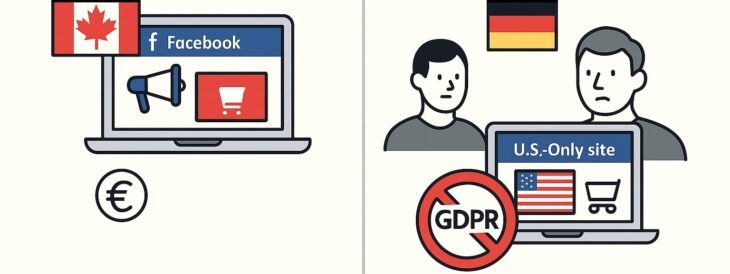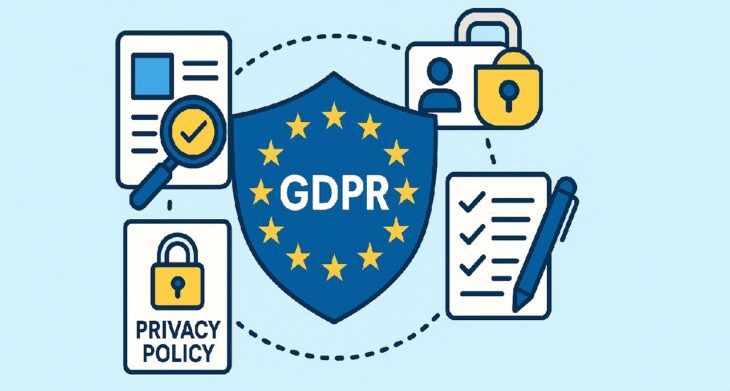The General Data Protection Regulation, better known as the GDPR, has been reshaping how businesses handle personal data since 2018. If you’re running a company that sells to, advertises in, or tracks users in the EU, this is a legal obligation with serious consequences if ignored.
But let’s be honest: the regulation’s depth can feel intimidating, especially if you’re outside the EU and just trying to run a business efficiently.
The good news? You don’t need to be a lawyer or privacy wonk to build a strong GDPR compliance strategy. What you do need is clarity, practical steps, and a real commitment to putting people’s data rights first.
It doesn’t matter if you’re a startup expanding into Berlin or exploring the Italy Golden Visa option, handling EU-based data correctly is non-negotiable.
Let’s break it all down, piece by piece—with the goal of helping you actually get compliant, not just talk about it.
Table of Contents
ToggleWho Needs to Care About GDPR?
Let’s start with a common misconception: “I’m based in the U.S./Canada/Australia, so GDPR doesn’t apply to me.” Unfortunately, that’s not how it works.
It applies if:
- Your company is based in the EU or EEA and handles personal data (which could be anything from an email address to a customer’s IP).
- You offer goods or services (paid or free) to EU individuals—even if your company is based elsewhere.
- You monitor behavior of people in the EU (think cookies, behavioral ads, or analytics tools that track users across sites).
How do you know if you’re “targeting” EU customers?
Here are some red flags that might trigger GDPR’s reach:
- Your site offers shipping to EU countries.
- You use a top-level domain like .de, .fr, or .eu.
- You accept euros or show pricing in multiple EU currencies.
- Your marketing is in German, French, Dutch—or any EU language.
- You run ad campaigns that explicitly target people in EU regions.
For example, if a Canadian ecommerce brand runs Facebook ads in German and offers PayPal in euros with shipping to Germany, it’s likely under GDPR’s scope.
On the flip side, if someone from Germany stumbles upon your U.S.-only site by accident, you’re probably in the clear.

The Core Principles You Need to Know
GDPR is built around seven guiding principles. You don’t need to memorize them word for word, but you do need to live by them in how your business handles data.
The Big Seven:
- Lawfulness, Fairness, and Transparency: Tell people what you’re doing with their data—and do it legally and fairly.
- Purpose Limitation: Don’t collect data “just in case.” Only gather what you need for specific, declared purposes.
- Data Minimization: Less is more. Don’t collect extra information just because it might be useful later.
- Accuracy: Keep information up to date—and correct it when needed.
- Storage Limitation: Don’t hang onto data longer than necessary. Set retention policies.
- Integrity and Confidentiality: Protect data with real security measures. Think encryption, not just passwords.
- Accountability: Be ready to prove you’re compliant—policies, records, and all.
In short: don’t be shady, don’t be sloppy, and document what you’re doing.
Key Roles and What They Mean
GDPR introduces some legal roles you may need to consider:
Data Controller
That’s usually you. The controller decides why and how personal data is processed.
Data Processor
A third party handling data on your behalf—like a cloud storage provider or email platform.
Data Protection Officer (DPO)
You’ll need a DPO if:
- You’re a public body.
- You monitor people on a large scale (e.g., via tracking tools).
- You handle large volumes of sensitive data (e.g., health info, racial data, criminal records).
If you don’t meet those thresholds, you can skip the DPO. But many companies find it helpful to assign someone as a point person for data privacy anyway.
EU Representative
If you’re outside the EU but fall under GDPR, you may be required to appoint a representative within the EU. This person acts as your go-between with regulators and customers.
There’s an exemption if your processing is occasional, doesn’t involve large-scale sensitive data, and poses low risk to people’s rights. Still, when in doubt, it’s smart to consult legal advice on this point.
What You Owe Your Users

GDPR is built to give people control over their own data. That means your users, customers, leads, even email subscribers, have rights you must respect.
Here’s what you need to be ready for:
| Right | What it Means |
| Access | People can request to see what data you hold on them. You must provide it for free, within 1 month. |
| Correction | If the data is wrong or incomplete, you must fix it. |
| Erasure | “The right to be forgotten.” People can ask for their data to be deleted. You have to comply unless there’s a valid reason not to (like tax law). |
| Restriction | They can ask you to stop processing their data in certain situations (e.g., during a dispute). |
| Portability | They can request a copy of their data in a format they can take elsewhere. |
| Objection | They can say no to data being used for things like direct marketing. You must honor this. |
| Automated Decisions | They can opt out of decisions made entirely by algorithms—like automatic credit scoring—unless it’s legally required or they’ve explicitly consented. |
To stay compliant, you’ll need processes in place to respond to these requests. That might mean forms on your website, a designated email address, and internal response workflows.
Legal Grounds for Processing Data

You can’t just collect personal data because it’s useful. You need a legal reason to do so.
Here are the six lawful bases under GDPR:
- Consent: The user has clearly agreed—opt-in boxes only, no pre-checked tricks.
- Contract: You need the data to fulfill a contract (e.g., shipping a product).
- Legal Obligation: Laws require you to collect or keep the data (e.g., invoices for tax).
- Vital Interests: Rare—used for emergencies, like saving someone’s life.
- Public Task: Mostly applies to public bodies and official authorities.
- Legitimate Interests: You have a real business reason, but it must not override someone’s rights.
If you rely on “legitimate interest,” be prepared to justify it with a documented assessment.
Real Steps to Actually Comply
This is where theory becomes action. Here’s how to get your house in order:
1. Figure Out If GDPR Applies
Start with a full review of your website, app, marketing efforts, and customer base. Are you selling or advertising to EU residents in any way? If so, you’re in.
2. Update Your Privacy Policy
Your privacy notice should:
- Be written in plain, clear language.
- State what data you collect and why.
- Name your legal basis for collecting it.
- List data subject rights.
- Include contact info for your DPO or EU rep (if you have one).
3. Map Your Data
Create a full inventory of what personal data you collect, where it’s stored, who has access, and which third parties process it.
4. Build Processes for User Requests
Train staff to handle subject access, erasure, and correction requests. Set up workflows to respond within 30 days.
5. Secure the Data
Encrypt it. Limit access. Regularly test for vulnerabilities. GDPR doesn’t prescribe exact tools, but it does expect strong protection.
6. Update Vendor Contracts
If you use third-party tools (email services, payment platforms, CRMs), those processors must be GDPR-compliant too. Review contracts to include required GDPR clauses.
7. Appoint an EU Rep or DPO (if required)
Figure out if your processing activities trigger this requirement—and get the right person in place if so.
8. Run a DPIA for High-Risk Activities
Are you using AI? CCTV? Large-scale profiling? You may need a Data Protection Impact Assessment.
What to Do If a Breach Happens

Data breaches aren’t always catastrophic hacks. Sometimes it’s as simple as emailing sensitive info to the wrong person.
If personal data gets exposed and there’s any risk to individuals’ rights (financial harm, identity theft, etc.), you must:
- Report to your supervisory authority within 72 hours.
- Inform affected individuals without undue delay, if the risk is high.
Even if you’re unsure, it’s better to report than to hide it. Regulators prefer transparency and swift response.
The Cost of Non-Compliance
Fines under GDPR aren’t symbolic.
- For serious violations, like ignoring user rights or processing data unlawfully, fines can reach up to €20 million—or 4% of global annual turnover, whichever is higher.
- For less severe offenses, like failing to report a breach or maintain proper records, fines can still hit €10 million or 2% of global turnover.
The most high-profile case so far? Meta (Facebook’s parent company) was fined €1.2 billion in 2023 over privacy violations related to targeted advertising.
But smaller companies aren’t immune. Regulators across the EU regularly investigate and penalize even mid-sized firms for failing to comply.
Meta has been fined a record €1.2B ($1.3B) by EU regulators for transferring user data to the U.S.
The fine nearly equals the €1.3B in total penalties already imposed against Meta for GDPR violations since 2021. pic.twitter.com/NfrobgDg8V
— INSIDE (@inside) May 22, 2023
Final Thoughts
GDPR compliance isn’t just about staying out of trouble—it’s about respecting the people you do business with. Customers are increasingly aware of their rights, and companies that handle data responsibly tend to earn more trust.
So whether you’re running a Shopify store that ships to Paris or a SaaS startup collecting leads in Berlin, take the time to do it right. Map your data, set up the right policies, and build privacy into everything you do.
Because when it comes to handling personal information, trust isn’t given—it’s earned.


